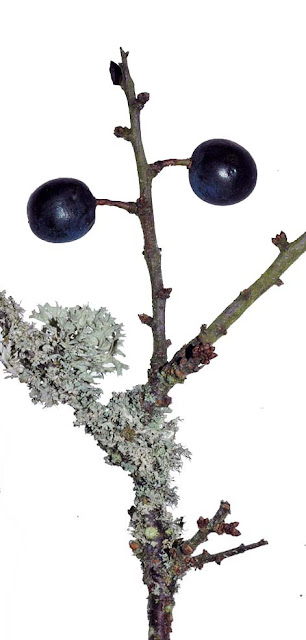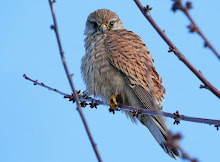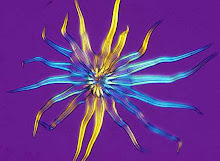Friday, December 30, 2011
Next Year's Christmas Card, an Early Spring and a Job Well Done .... ..........
While we were out walking in Teesdale this morning we encountered this very obliging Robin ......
.... that struck a variety of poses that might be suitable for next year's Christmas cards.
Incredibly, hazel catkins are coming into bloom along the River Tees near the Meeting of the Waters. With a mild weekend forecast they look like they'll be shedding pollen in the New Year. Strange days indeed.....yesterday we saw lesser celandines in bloom in Sunderland (but I forgot to take a photo).
Meanwhile, lambing will begin in a few weeks. We spotted this magnificent ram in a field of sheep, with a contented look on his face that suggests a job well done....
Thursday, December 29, 2011
Drying Wings and Wet Feet
On our walk along the coast today from the National Glass Centre in Sunderland to Seaburn we passed several cormorants near St. Peter's marina ......
...... drying their waterlogged wings at the end of a fishing session.
Due to their superior fishing skills cormorants tend to be unpopular with fishermen but along this stretch of coast they are the subject of some fine examples of public art, including an impressive series of metal sculptures and ...
... this very attractive weather vane on the bank of the river, where .....
..... this red-throated diver in winter plumage was also out fishing in the River Wear estuary.
These sanderling, perched on a rock off Roker beach, were just about to be displaced by the incoming tide and I was concentrating so hard on taking their photograph that I didn't notice the threat until the waves were lapping around my ankles. That's not the first time it's happened either - one of the perils of seashore photography. I completed the rest of the walk with squelching shoes.....
Labels:
Cormorant,
red-throated diver,
River Wear,
Sanderling,
Sunderland
Wednesday, December 28, 2011
Skeletons.....
I threw these old seed heads of henbane Hyoscyamus niger on the compost heap back in the autumn and since then winter weather and fungal decay have done their work, reducing them to skeletons and revealing their complex network of veins.
More skeletonised plants here
Labels:
henbane,
Plant anatomy,
skeleton leaf
Tuesday, December 27, 2011
Elusive Black Grouse
Teesdale has a very famous black grouse lek and the numbers of this spectacular game bird seem to be increasing. In winter they sometimes disperse away from Teesdale and I occasionally see them in Weardale in winter, in rushy pastures. This one has taken up residence near Woodland, between Weardale and Teesdale, and I've being trying to photograph it for some time. I'm accustomed to seeing them on the ground but they also like to perch in trees and this one has a liking for the hawthorns beside the road. The first time I tried to photograph it I took the picture through the car window, which confused the autofocus and I got this fuzzy image. When I wound the window down ....
.... the bird immediately took flight, so all I got was a picture of its bum and a lump of black grouse poo (bottom left-hand corner of picture) in mid-air (is this a first?).
Today, when we were on out way down to Teesdale it was once again perched in the hawthorns, and once again it took flight as soon as I stopped the car ..... but at least this time it perched on a fence and I got this distant shot.
Frustrated again .... but I'll be back.
Meanwhile a walk along the Tees in the rain, downstream from Middleton-in-Teesdale, was notable for numerous velvet shank Flammulina velutipes toadstools - they are usually associated with freezing weather which they seem to tolerate, but this Christmas warm weather seems to have suited them very well too.
Labels:
Black grouse,
Flammulina velutipes,
Teesdale,
velvet shank
Monday, December 26, 2011
Santapede
This centipede Lithobius forficatus broke cover and raced across the floor when I was shifting some flower pots around in our conservatory in Christmas Day. Centipedes lose water very easily through their exoskeleton, so tend to spend much of their time in crevices and prefer to rest in places where there is something solid above and below them - under a stone (or flowerpot) for example, where their flattened shape allows them to crawl into small spaces. Providing this one with a piece of wet paper to rest on gave it an opportunity to top up its water supply and allowed me just enough time to photograph it before it raced for cover.
It always comes as a bit of a disappointment to learn that there are no centipedes with 100 legs and L.forficatus has a mere 15 pairs. The hind two pairs are much longer than the others and have more of a sensory than a locomotory role, because when the animals wedge themselves in crevices they often have to reverse out - I guess you can think of those long hind legs as the invertebrate equivalent of parking sensors fitted to the rear of expensive cars. For these beautifully articulated animals, reversing out of a narrow gap must be rather like reversing a car with fifteen trailers attached.
Centipedes have very poor eyesight so rely heavily on their antennae for locating food and monitoring their surroundings by touch and smell. Understandably, they take great care of their antennae and this one is drawing the left antenna through its jaws to clean it. The jaws are located out of sight under the head and are separate from those lethal venomous fangs on each side of the head.
Centipedes have one pair of legs per segment, while millipedes have two, but L.forficatus hatches from the egg with only seven segments and seven pairs of legs - additions are made with each moult, until a full complement of 15 segments and pairs of legs is reached.
Labels:
centipede,
Lithobius forficatus,
soil animals
Saturday, December 24, 2011
Look Behind You! Boo!! Hiss!!!
A very Merry Christmas (and pantomime season) to all visitors to this blog - and thank you for all the comments over the last year.
These wonderful pantomime dame wigs - made from papier mache and currently on display at Newcastle City Library - are the work of Keith Wigham (yes, really!) who also performs as a pantomime dame at the People's Theatre, Heaton. More about him here.
These wonderful pantomime dame wigs - made from papier mache and currently on display at Newcastle City Library - are the work of Keith Wigham (yes, really!) who also performs as a pantomime dame at the People's Theatre, Heaton. More about him here.
Labels:
Keith Wigham,
Pantomime wigs,
Pantomimes,
wigs
Friday, December 23, 2011
The Heat, The Flies.....
Unseasonably mild weather tempted this blowfly to buzz around our conservatory. I persuaded it to stay still long enough for a photograph by providing it with a drop of honey......
Thursday, December 22, 2011
Eggleston Burn
Today's Guardian Country Diary describes a visit to the steep-sided valley cut by Eggleston Burn in Teesdale, as it flows down into the river Tees at Eggleston. Confusingly, there is an Eggleston and an Egglestone in Teesdale, upstream and downstream of Barnard Castle respectively, and this is the view along Eggleston Burn from the old stone bridge that carries a road across it, just north of Eggleston village. You can see the shadow of the photographer about two thirds of the way up the right-hand side of the picture, where the shadow of the bridge cuts across!
The footpath down to the beck is reached by this very narrow stile in the bridge parapet. The path through the woods from here is treacherous in places, with a long, steep drop into the burn on one side....
.... and you can hear the sound of fast-flowing water growing louder as you descend.
You can follow the footpath for about a quarter of a mile before it turns away from the burn and climbs back up through pastures and only the moorland.

The valley is sheltered from prevailing south-westerly winds and the burn keeps the humidity high all year-round. This provides ideal conditions for growth of mosses and lichens on the ancient hawthorns and blackthorns on the burn-side ........
This bushy lichen is, I think, a species of Usnea - possibly U. subfloridiana..
.... and I think this may be Evernia prunastri..
So far the redwings and fieldfares haven't got to the hawthorn berries....
...... or the sloes, which have softened and split after last week's frosts. The combination of grey lichens, scarlet berries and blue-black sloes provides festive decorations for bare twigs in the depths of winter.
Labels:
Eggleston,
Eggleston Burn,
Evernia,
Guardian Country Diary,
Hawthorn,
Lichens,
Sloe,
Teesdale,
Usnea
Sunday, December 18, 2011
A Tree-spotter's Guide to Conifer Cones: 2
It's not easy to get your hands on intact cedar of Lebanon Cedrus libani cones because they tend to remain firmly attached to the tree and, at the end of their three year ripening period, break up without falling to the ground. This cone has reached the stage where it is about to disintegrate and is about 8 cm. long. The best way to obtain a cedar of Lebanon cone is to check out trees after gales - a broken branch will often have cones attached. Young cones have a lovely cedar fragrance. The tree has been grown in Britain since 1638 but most date from after 1740 when a famously severe frost killed many of the young trees - so the oldest specimens here are still quite youthful, compared with trees in their native Lebanon that are speculated to be up to 2500 years old. The tree is portrayed on the Lebanese flag and is protected in its native country, where only ten small natural populations remain.
This is a ripe Sitka spruce Picea sitchenis cone, which has thin scales that have a crinkly edge. It comes from the North West coast of North America and, like the Douglas fir, it was discovered by Archibald Menzies and introduced into Britain by David Douglas in 1831. It has been an extremely successful plantation tree in upland Britain and cones prolifically, but sadly closely-spaced plantation trees can never display the full majesty of this species, which can grow to 60m. tall and become very handsome as an isolated specimen. This cone is about 8cm. long.
More pictures of cones here
For more posts on this blog on tree ID - buds, bark, flowers or fruits - click here
Labels:
Cedar of Lebanon,
Cedrus libani,
Picea sitchensis,
Sitka spruce,
Trees
Friday, December 16, 2011
Sloe gin
Frost and snow lately has finally softened the sloes on blackthorns in Teesdale and Weardale and there's a real temptation to taste a ripe one - a temptation to be resisted. I did once - and only once - and it was so breathtakingly sour that I'll never do it again. There's only one way to consume these - as sloe gin, marinaded in gin and sugar for a few months.
Labels:
blackthorn,
Prunus spinosa,
Sloe,
Sloe gin
Wednesday, December 14, 2011
Elder and Lichens
Lichens are just about the most colourful objects in the landscape hereabouts at this time of year. This one is a Xanthoria species - Xanthoria parietina I think - growing on an elder twig. The little orange discs are apothecia, which produce the spores from the fungal component of the symbiotic relationship between the alga and fungus that constitutes a lichen.
Old elders (is that a tautology?) are often smothered with this yellow lichen, bringing the whole tree to life when it's lit by winter sunshine. X.parietina thrives in sites where there is plenty of nitrogen in the substrate, such as tree branches where birds have perched and left droppings.
Sunday, December 11, 2011
Skeleton leaf
I found this almost intact skeleton leaf when it was raking up the leaves from under the hedge. The network of smaller and smaller veins is the plant's amazing distribution and collection system for the living cells in the leaf - water carried outwards via the xylem to the outer reaches of the leaf then sugars, made by photosynthesis in the leaf cell chloroplasts, carried back into the plant. A wondwerful example of the beauty of the functional in nature...
Labels:
Plant anatomy,
skeleton leaf
Friday, December 9, 2011
What does it feel like to swallow a live crab...?
After yesterday's gales the sea was a tad choppy along the Roker seafront at Sunderland today.....
.... but with reassuring British fortitude this couple were taking afternoon tea on the promenade as the waves smacked into the sea wall...
.... meanwhile, in the sheltered mouth of the River Wear this eider duck was fishing for crabs .....
..... spending quite a while manoeuvring this one into the right position in its beak so that it could swallow it in one gulp. I wonder what it feels like to swallow a live (and very angry) crab?
Meanwhile, the rough seas and rising tide had driven the turnstones up onto the promenade .......
.... where the starlings were taking a bath in the puddles left by yesterday's torrential rain.
Labels:
Eider,
River Wear,
starling,
Sunderland,
Turnstone
Subscribe to:
Posts (Atom)







































































